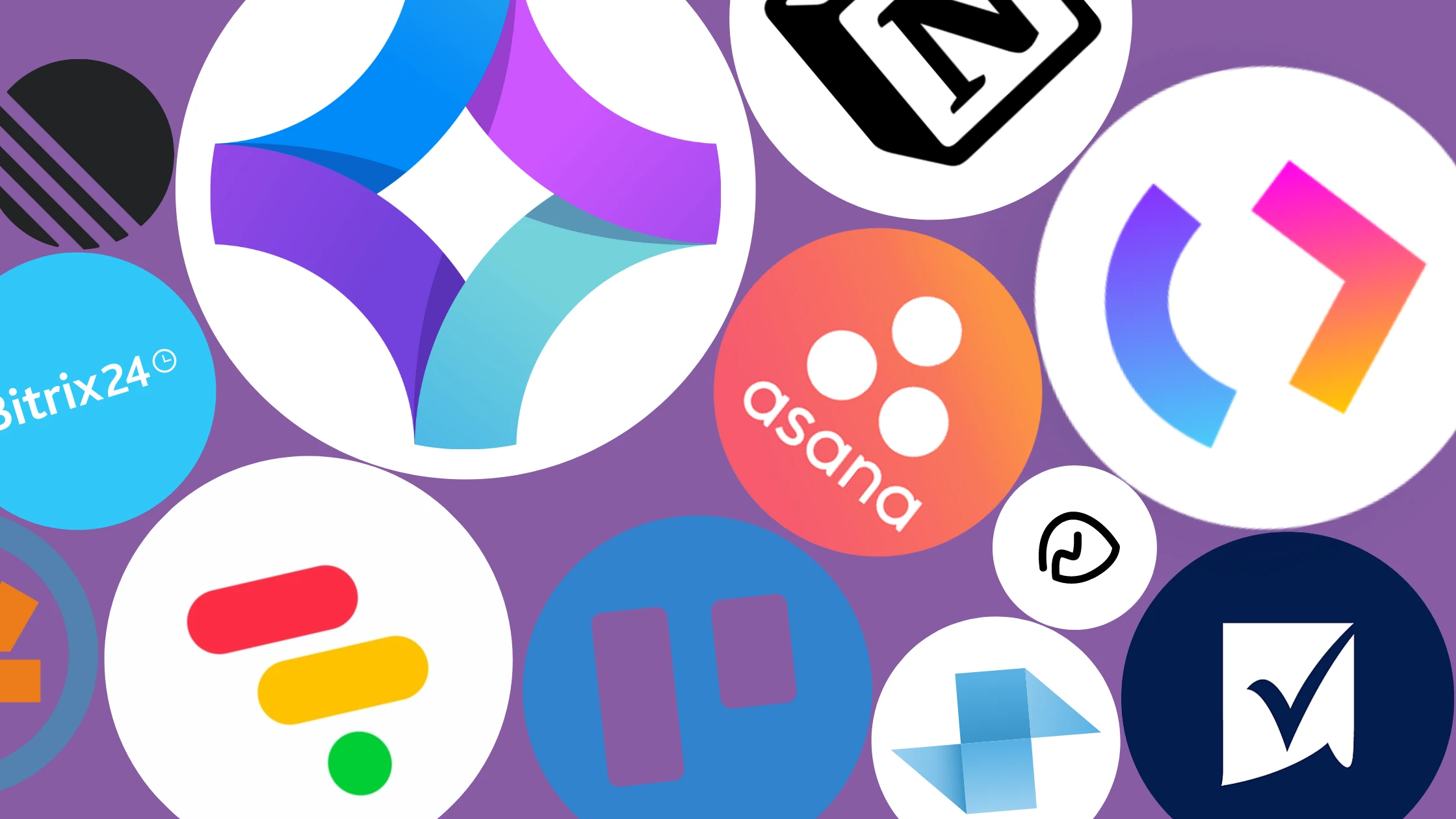For those who are facing challenges with Jira and looking for a different solution, we have exactly what you need.
Our team has meticulously compiled a comprehensive list of 16 top alternatives to Jira for managing projects and keeping track of tasks.
You’ll find a diverse array of options in our selection, each with unique features to match your specific project requirements and budgetary considerations. Our assortment encompasses everything from cloud-based platforms and open-source options to self-hosted systems and traditional workflow management tools. Dive in to explore and choose the ideal option for your team!
Continue reading to identify the most suitable Jira substitute that aligns with your team’s needs.
Table of Contents
What is Jira?
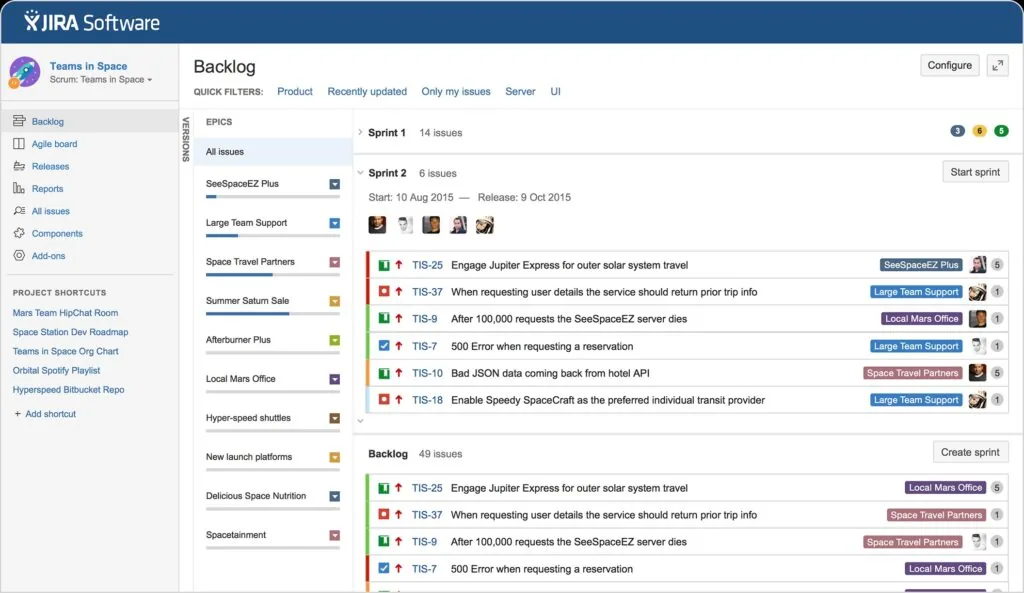
Atlassian’s Jira stands out as a highly valuable resource in the realm of agile project management. This software significantly enhances team collaboration, offering straightforward communication channels for effective engagement.
For a comprehensive evaluation, please refer to our full review of Jira.
Key Features of Jira Software:
- Seamless integration with various external systems
- Detailed insights into team activities
- Configurable permission settings for enhanced security and control
- Support for completing scrum projects efficiently
- Customizable workflows to suit specific project requirements
- Advanced incident investigation capabilities, vital for release management
- Comprehensive bug tracking functionality
- Extensive adaptability with the addition of countless custom fields
Undoubtedly, Jira presents itself as an exceptionally versatile tool for project management.
Nevertheless, exploring alternatives to Jira is a sensible approach for several reasons, which we will discuss further.
What Features to Look for in a Project Management Tool Like Jira?
In the search for a suitable Jira alternative, it’s essential to consider a range of pivotal features that ensure a seamless project management experience. Key elements to focus on include:
- An effective alternative should boast advanced project planning and scheduling capabilities. This encompasses task creation and management, deadline setting, resource allocation, and progress tracking.
- Opt for a tool that augments team collaboration and communication. Essential features should include commenting, @mentions, file sharing, and real-time messaging capabilities.
- For teams adhering to agile methodologies, select a tool that comprehensively supports these practices. Key functionalities should include kanban boards, scrum boards, effective backlog management, and detailed burndown charts.
- The ability to tailor workflows, fields, and dashboards is crucial in a project management tool. Choose a solution that offers extensive customization to align with your team’s unique requirements.
- Assess the tool’s ability to integrate with other essential software and tools used by your team. Essential integrations might include popular platforms like Slack, GitHub, Zendesk, among others.
- A competent project management tool should offer in-depth reporting and analytics features. Look for the capability to generate customizable reports, monitor team performance, and provide insightful project progress analysis.
- The usability of the tool is a critical factor. A tool with a straightforward, intuitive interface is preferable, ensuring ease of navigation and effective utilization by all team members.
16 Best Jira Alternatives in 2024
1. Teamplate

Teamplate distinguishes itself as a formidable alternative to Teamwork, emerging as a versatile project management platform renowned for its comprehensive suite of sophisticated features. These features are intricately designed to streamline task management, enabling teams to handle various project elements such as checklists, epics, and sprints with efficiency. This innovative strategy revolutionizes project management, setting a new standard in organization and execution.
At its core, Teamplate presents an extensive range of capabilities that enhance clarity and efficiency in project management. This powerful solution adeptly accommodates teams of various sizes, empowering them to manage projects with exceptional precision and agility. Teamplate goes beyond basic project management functionalities, offering a dynamic platform that evolves with team collaboration and project development.

Key Features of Teamplate:
- Teamplate facilitates the creation and management of epics, offering a panoramic view of project progress and a deeper comprehension of project objectives.
- Emphasizing the importance of timing, Teamplate’s sprint feature enables teams to divide work into manageable segments, focusing on specific tasks within designated periods. This method enhances efficiency and aids in tracking project progress.
- Incorporating agile methodologies, Teamplate equips teams to excel in dynamic project environments.
- The platform’s design prioritizes task management, making it an ideal solution for organizations of varying scales.
- Teamplate’s checklist functionality offers meticulous task breakdown, ensuring comprehensive management and oversight.

Advantages of Teamplate:
- The combination of checklists, epics, and sprints offers unparalleled flexibility, reducing uncertainty in project execution.
- Teamplate’s per-user pricing model caters to a wide range of business needs, from small teams to large enterprises.
- The platform’s embrace of agile practices ensures swift adaptation to changing project scenarios.
- Its straightforward interface allows for quick adoption and effortless use.
- Teamplate includes specialized tools designed for effective communication and collaborative decision-making.
Pricing:
- free
2. Binfire
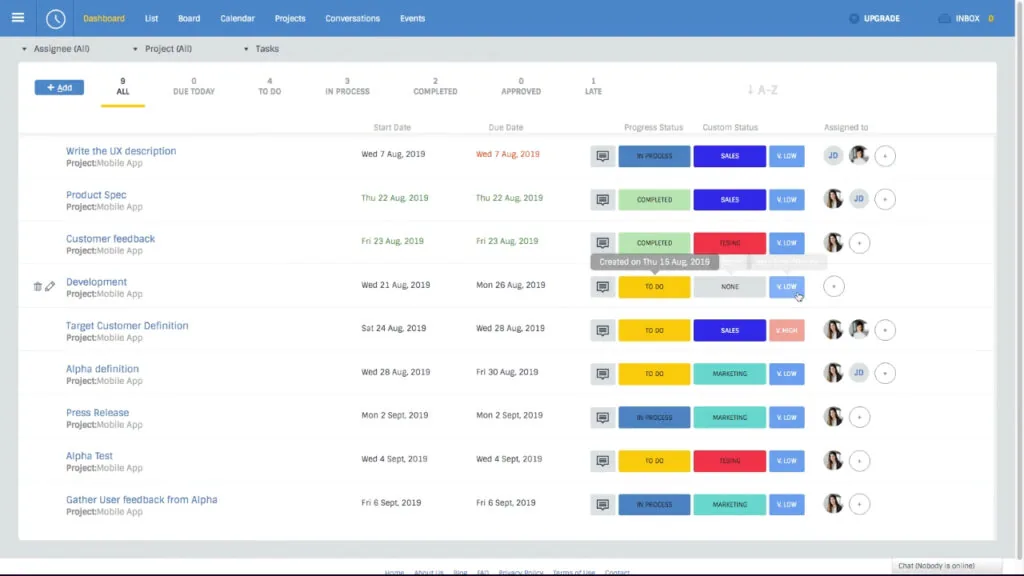
Binfire, a dynamic project management tool, is meticulously designed to cater to the intricate needs of software development teams, particularly those involved in agile project management. This comprehensive project management software offers a diverse range of functionalities, making it one of the best Jira alternatives currently available in the market.
Key attributes of Binfire include advanced task management features, a Kanban board, and an interactive Gantt chart. These components integrate seamlessly to facilitate complex project management scenarios. Moreover, it encompasses a full suite of collaboration features necessary for efficiently handling both small-scale and large-scale projects.
One of the defining elements of Binfire is its ability to create a virtual office environment. This is particularly advantageous for teams engaged in agile project management, as it allows for effective remote collaboration across various geographical locations. It’s noteworthy that Binfire has successfully been employed for collaborative project management by large remote teams spanning three continents, emphasizing its capability as a versatile project management tool.
Key Features of Binfire:
- Essential for organizing and handling multiple aspects of project management.
- These features facilitate effective task management and scheduling within project management software.
- Interactive Whiteboard and Project Template: Ideal for teams following agile project management methodologies.
- Project Status Report, Interactive Gantt Chart, Activity Stream, and Burndown Chart: These tools are crucial for software development teams dealing with complex project management.
Limitations of Binfire:
- A potential drawback for those seeking extensive connectivity with other applications.
- May present challenges for beginners, especially in comparison with other project management tools.
- An area where Binfire trails behind the best Jira alternatives.
Pricing:
- While Binfire doesn’t offer a free plan, it starts at $6.50 per user per month. Those interested in exploring its capabilities as one of the best Jira alternatives can take advantage of this pricing model to access its comprehensive project management functionalities.
3. Basecamp

Basecamp stands out as a user-friendly project management tool, adept at uniting diverse roles towards a shared objective. It’s particularly effective for teams that find themselves limited by Jira’s complexity, especially those not involved in developer-centric tasks like bug and issue tracking.
For groups seeking a simple project management solution to collaboratively complete projects, Basecamp emerges as a viable Jira alternative. It offers a flexible pay-as-you-go pricing model, devoid of binding contracts, and includes an annual package option for those who wish to access its full spectrum of advanced features.
A notable advantage of Basecamp is its pricing structure, which is not user-dependent. This means you can involve as many team members as necessary without worrying about additional costs. Upon engagement, users quickly discover Basecamp’s efficiency in task delegation and its prowess in tracking project progress, even across multiple projects.
Basecamp is particularly beneficial for teams dispersed across different time zones, offering capabilities that significantly enhance remote project management. This agile project management software boosts work agility and productivity, seamlessly catering to the needs of diverse project management teams.
Key Features of Basecamp:
- Streamlines communication within the team.
- Facilitates easy access to project materials.
- Ideal for maintaining to-do lists and task tracking.
- Automatic Check-in Questions: Streamlines daily standups.
- Allows clients and customers to view tasks and communicate efficiently.
- Group Chat & Direct Messaging: Enhances team collaboration.
- Task Reporting: Provides insights into task completion and project progress.
Limitations of Basecamp:
- Absence of Time Tracking: A notable omission within the platform.
- Restricts flexibility for tasks and projects.
- Lack of Built-in Dependency Management: A disadvantage for handling complex projects.
Pricing:
- Basecamp offers a complimentary personal plan, with a paid plan priced at $99/month for unlimited users, making it a cost-effective solution for managing multiple projects.
4. Pivotal Tracker

Pivotal Tracker emerges as a prominent agile project management tool, tailored to streamline task management and enhance collaboration within teams. This platform stands out among Jira alternatives, offering a user-friendly interface that focuses on simple project management while packing advanced features.
Key to Pivotal Tracker’s appeal is its ability to provide a unified view of priorities, aiding teams in determining which tasks to address next. As a formidable competitor to Jira, Pivotal Tracker brings forward tools such as backlog lists, features, and hotfixes, simplifying the process of task selection for your agile software development team. A notable feature is the calculation of team velocity, based on story points completed in each iteration, offering a quantitative measure of the team’s progress.
Pivotal Tracker further supports planning with its guided tracker tool, enabling teams to segment work into manageable portions, enhancing the ability to track project progress effectively.
Key Features of Pivotal Tracker:
- Aid in estimating and prioritizing work collaboratively.
- Ensures a streamlined workflow.
- Allows efficient management of various projects simultaneously.
- Tracks time and trends, providing crucial insights.
- Facilitates iterative planning and task tracking.
Limitations of Pivotal Tracker:
- Not ideally suited for non-agile or large-scale projects.
- Some users may find the interface cluttered and less intuitive.
- Limited reporting features restrict the generation of detailed insights.
Pricing:
- Pivotal Tracker offers a free plan for up to five users, making it an accessible option for smaller teams. For larger teams, the paid plans begin at a reasonable $10 monthly flat rate. This pricing structure, combined with the option for a free trial, makes Pivotal Tracker an attractive choice for those seeking efficient and budget-friendly project management tools.
5. Asana

Popular among agile teams for its comprehensive project management features. Serving as an effective alternative to Jira, Asana excels in facilitating communication and collaboration across project management teams.
Asana is equipped with a kanban style board view, making it an ideal choice for visual project management. This feature, along with workflow automation capabilities, greatly aids in organizing tasks and streamlining project planning. The platform’s ability to handle task dependencies enhances its utility for more complex project management scenarios.
Among Asana’s notable features are its multiple workspaces, enabling users to assign tasks, attach relevant documents, and engage in real-time collaboration. Its transparency, showcased through the visibility of co-workers’ tasks and priorities, is crucial for the agility and efficiency of any project. Moreover, Asana’s adaptability across various devices and browsers allows for continuous tracking of project progress.
Asana diminishes the reliance on third-party applications or emails for corporate communications. By leveraging this project management system, teams can significantly improve workflow efficiency, task management, and overall project execution. Asana also stands out for its dedicated tech support, readily accessible through various communication channels.
Key Features of Asana:
- Multiple Workspaces: Facilitate efficient project management.
- Keep track of all project activities.
- Provide easy reference to important documents.
- Calendar View: For effective time tracking and deadline management.
Limitations of Asana:
- Lack of Built-in Chat: Misses real-time chat functionality for immediate collaboration.
- Limited Advanced Features in Free Plans: Timelines and custom fields are exclusive to paid subscriptions.
- Scope of Projects: More suitable for simple project management, and may not be ideal for handling highly complex projects.
Pricing:
- Asana offers a free plan. Their paid plans start from $10.99/user per month.
6. Shortcut

Shortcut, formerly known as Clubhouse, has rapidly gained popularity as a Jira alternative, largely due to its user-friendly interface which maintains the project management functionality akin to Jira, but with a more streamlined presentation.
This tool simplifies task tracking and project organization while avoiding the often cluttered and dated feel of Jira’s interface. Shortcut’s approach starts with the concept of a “story,” allowing users to incorporate tickets, bugs, or chores, thereby shaping the narrative of their project.
In addition to its straightforward interface, Shortcut provides an array of project templates and visual aids like Gantt charts, enhancing its utility in organizing tasks and time tracking. The software also includes a variety of charts for effective monitoring of burndowns and estimates.
Key Features of Shortcut:
- User-Friendly Interface: Eases navigation and task management.
- Facilitates collaboration and documentation.
- Reporting Dashboards and Progress Reports: Offers insights into project status.
- Extensive API: Supports the creation of open-source projects.
- Compatible with Github, Bitbucket, Slack, and more.
- Knowledge Base Feature (Beta) – A new addition to its suite of tools.
Limitations of Shortcut:
- Limited Integrations, this may pose challenges in achieving a seamless workflow management.
- New users might find the interface somewhat cluttered.
- Compared to other project management tools, Shortcut offers fewer customization possibilities.
Pricing:
- Clubhouse offers a free plan. Their paid plans start at $8.50/user per month.
7. ProofHub

ProofHub emerges as a popular project management tool and an excellent Jira alternative, renowned for its versatility in managing teams and projects with enhanced efficiency. This platform excels in task organization and provides a cohesive approach to service management, encompassing various essential features.
Central to ProofHub’s appeal is its ability to serve as a unified source for task management, offering straightforward to-do lists, agile workflows, kanban boards, and Gantt charts for visual project timelines. This comprehensive suite of tools enables teams to efficiently organize tasks and track progress, while its built-in chat app consolidates office communications in one location. Additionally, ProofHub’s online proofing tool streamlines the review and feedback process, enhancing collaboration.
Another significant aspect of ProofHub is its capabilities in resource management. It offers a dedicated space for real-time discussions and custom reports, facilitating better oversight and management of both projects and resources. Integration with third-party applications like Google Drive, OneDrive, Dropbox, and Box further enhances its utility by centralizing access to all project-related data.
Notably, ProofHub’s user-friendly interface stands out as one of its best features, ensuring a smooth onboarding experience. With minimal learning curve, new users can quickly adapt to its system.
Key Features of ProofHub:
- To-Do Lists – Streamlines task management.
- Custom Workflows and Kanban Boards: Offers flexibility in project execution.
- Gantt Charts: Aids in detailed project planning.
- File Management: Organizes project files effectively.
Limitations of ProofHub:
- No Personalized Workspace Options – this might limit user experience customization.
- Limited Integration Range: Falls short in comparison to other project management tools.
- User Interface Challenges: The interface may not be as intuitive as some of the best Jira alternatives.
Pricing:
- Simple, no per-user pricing. The Ultimate Control plan with unlimited users and projects available at $89/month (billed annually).
8. Notion
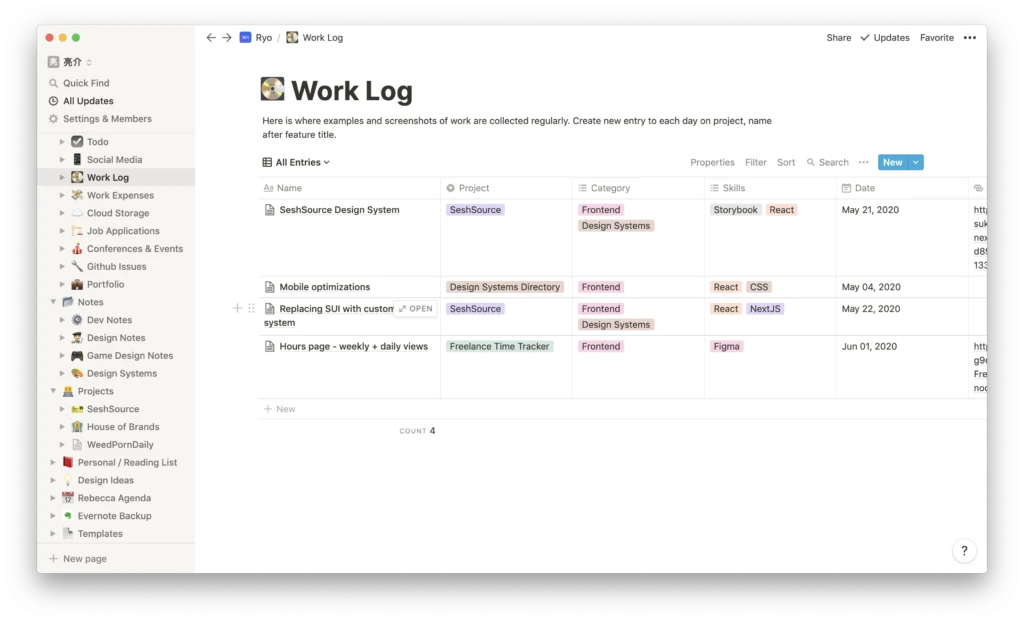
Businessmap positions itself as one of the best Jira alternatives, particularly for those seeking to manage multiple projects and streamline workflows. This agile project management tool enables teams to efficiently visualize key initiatives and break them down into manageable tasks using intuitive kanban boards.
The software offers an array of features designed to enhance managing tasks, including Work In Progress limits, filters, role-based access, and customizable fields. These elements allow teams to adapt the visualization of work to their specific preferences. Businessmap’s versatile kanban boards are ideal for creating and managing multiple custom workflows, while the timeline workflow feature provides an alternative approach to project planning.
Additionally, Businessmap facilitates time tracking, enabling users to monitor hours spent on tasks or projects. This is complemented by comprehensive analytics that aid in performance monitoring.
Key Features of Businessmap:
- Custom Workflow Analytics: Provides insights to measure team and project performance.
- Timeline Planner – assists in creating detailed project roadmaps.
- Multiple Workflow Management: Enhances the ability to organize and manage various tasks.
- Visual Performance Tracking: Utilizes tools like cumulative flow diagrams and cycle time heatmaps.
Limitations of Businessmap:
- The extensive features and complex interface may be overwhelming for smaller businesses.
- The lack of extensive integration capabilities can restrict collaborative efforts.
- New users may find it challenging to navigate and utilize the software’s complex functionalities.
Pricing:
- Businessmap has a standard plan that costs $149/month.
9. Smartsheet
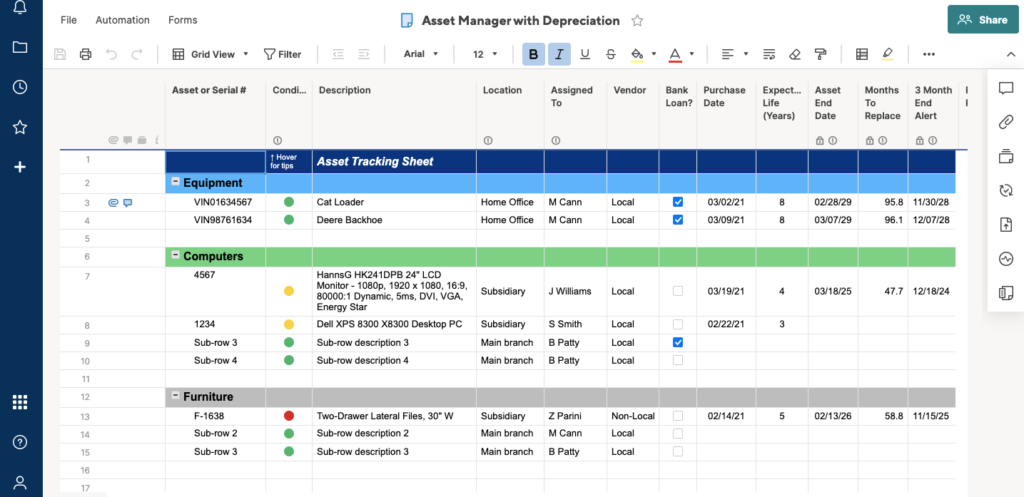
Smartsheet stands out as a comprehensive cloud-based collaboration software, adeptly catering to the needs of project managers who prefer a spreadsheet-style approach but require more advanced functionalities. As one of the best Jira alternatives, it offers an attractive, modern interface, coupled with flexible and powerful features to streamline project management.
Key Features of Smartsheet:
- Visual Timelines/Gantt Charts: Facilitate mapping out task dependencies and critical paths, essential for effective project planning.
- Significantly reduce manual tasks and enhance efficiency, particularly in handling repetitive tasks.
- Simplify data collection and management, aiding in efficient tracking tasks.
- Reports and Dashboards: Provide crucial insights and support informed decision-making with robust reporting capabilities.
- Task Assignments: Enable clear and organized task allocations among team members.
Limitations of Smartsheet:
- Spreadsheet-Based Format: While unique, it may not appeal to all users, especially those looking for a more traditional project management tool.
- Limited Third-Party Integrations might impede collaboration efficiency for teams reliant on extensive integration capabilities.
- The available customization options might not fully satisfy specific, tailor-made project management requirements.
Pricing:
- There are three price tiers, including a free trial. Paid plans start at $7 per user per month.
10. Monday.com
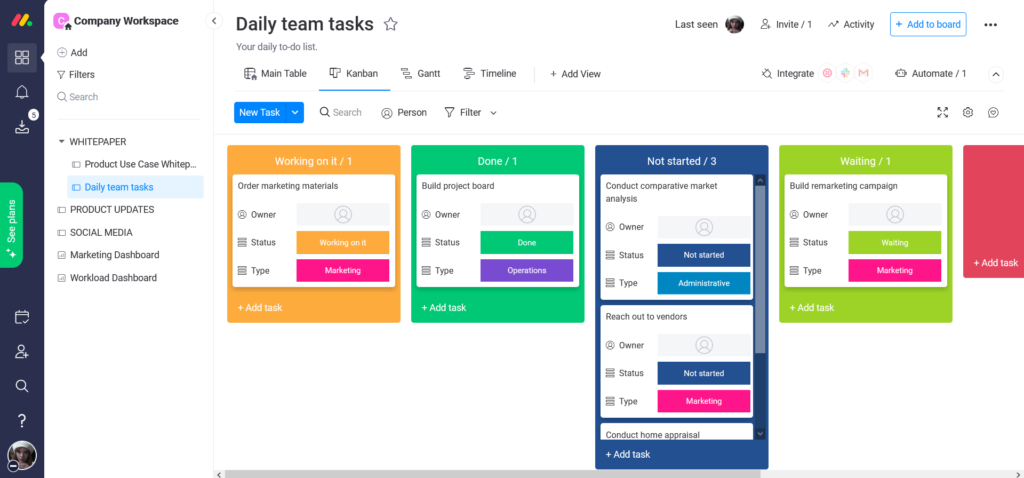
Monday.com is widely recognized as a versatile cloud-based collaboration software, making it an ideal choice for agile businesses and a flexible alternative to Jira. Praised for its user-friendliness, Monday.com caters to a diverse range of teams and industries, offering features that streamline work management. It allows project managers to easily customize views, track tasks, and generate detailed reports, enhancing overall efficiency and data management.
Key Features of Monday.com:
- Open API Architecture: Facilitates seamless integration with various systems.
- Native Integrations: Ensures compatibility and smooth workflow across different platforms.
- Detailed Reporting: Enhances reporting capabilities, allowing for comprehensive analysis and tracking of tasks.
Limitations of Monday.com:
- Learning Curve: The platform may present a steep learning curve, which can be challenging for individuals less familiar with tech-heavy interfaces.
- Limited Functionality in Free Version: The basic plan may restrict access to advanced features, which might be a concern for budget-conscious users.
- Customer Support: Slower response times in customer support could impede prompt resolution of issues, impacting user experience.
Pricing:
- Monday’s free plans start at $12/month per user for the basic plan.
11. Backlog by Nulab
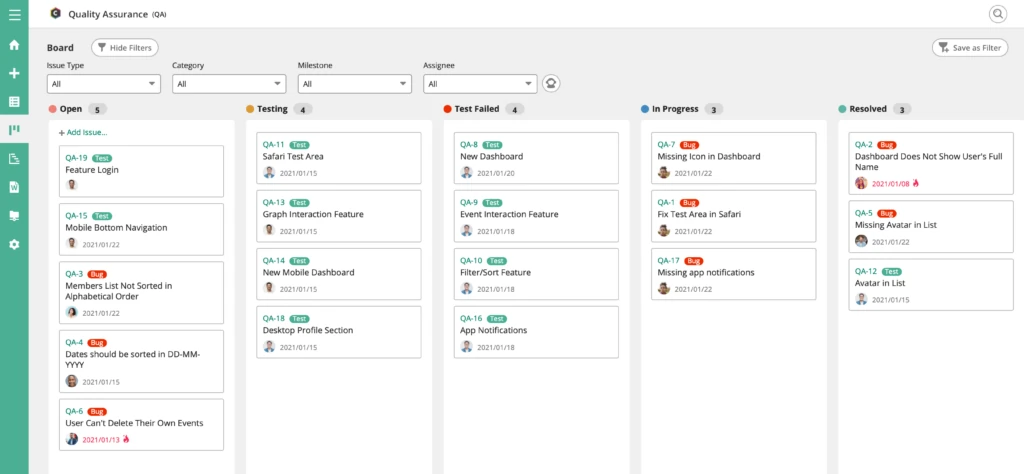
Backlog stands out as a project management tool specifically designed to prioritize and track work, featuring a user-friendly interface that facilitates enhanced team collaboration, particularly among development teams.
Key Features of Backlog:
- Git Hosting & Private Git Repository: Offers secure and efficient code management.
- Enables visual planning with gantt charts and tracking of project timelines.
- Wikis – provides a centralized space for team knowledge and documentation.
- Allows personalization to meet specific project requirements.
- Streamlines the process of reporting and tracking bugs.
Limitations of Backlog:
- Lack of Integrated Chat Functionality: Necessitates the use of additional tools for team communication.
- The interface may present navigational difficulties, especially for those without a technical background.
- Backlog might not fully meet the demands of more intricate project management scenarios.
Pricing:
- Backlog plans start at $29.17/ month for up to 30 users and go up to $145.83/ month for unlimited users.
12. Bitrix24

Bitrix24 is a comprehensive social enterprise platform that seamlessly integrates project management, CRM, and communication tools into a single cohesive system. It’s designed to streamline task management and enhance collaboration, making it suitable for both small teams and large organizations.
Bitrix24 is remarkably versatile, catering to various departmental needs including sales, marketing, management, HR, legal, and customer service. Its flexibility and broad functionality make it an ideal choice for diverse business operations.
To delve deeper into what Bitrix24 has to offer, consider exploring our detailed review of the platform.
Key Features of Bitrix24:
- Intranet, chat, video conferencing, and calendars facilitate internal communication and scheduling.
- Comprehensive Workspaces and Tasks Management: Enhances task organization and performance tracking.
- Streamlines document handling and storage.
- Attendance Management and Work Reports: Supports effective system management with workflow automation.
- Monitors work hours accurately.
- Offers a variety of adaptable templates for different business needs.
Limitations of Bitrix24:
- Some users experience limitations in mobile app functionality and find it less user-friendly.
- The CRM features, while robust, could offer more in terms of customization and flexibility.
- Costs may escalate with additional users and the need for extended functionality.
Pricing:
- Bitrix24 has paid plans starting from $24/ month for two users. They also offer a free plan.
13. Wrike

Wrike stands as a sophisticated project management tool, akin to Jira, designed to cater to the nuanced needs of mid-sized and enterprise-level teams. Its primary focus is on simplifying planning, enhancing visibility, and streamlining workflows, making it a viable option for a wide range of project management styles, including both waterfall and agile methodologies.
As a cloud-based collaboration software, Wrike offers extensive customization options, allowing teams to tailor their workflow and enhance productivity. It features Gantt charts and robust reporting capabilities to keep track of team progress efficiently.
For those considering alternatives, it’s worth exploring other options comparable to Wrike.
Key Features of Wrike:
- Customizable Dashboards: Offer tailored views for different project needs.
- Workload Charts for Resource Management: Enable effective allocation and management of team resources.
- Support for Time Tracking, monitoring the time spent on various tasks.
- Facilitate better teamwork and financial planning.
- Organized Dashboards with Drag and Drop Functionality: Simplify task organization and management.
- Streamline the creation of various types of reports.
Limitations of Wrike:
- The basic plan offers limited functionality, requiring premium plans for full access to features.
- Complex Interface: May pose challenges to first-time users, adding a learning curve to the platform.
- Lack of Native Time Tracking: Absence of this feature within the platform necessitates external solutions for time tracking.
Pricing:
- Wrike offers a free plan, and the paid plans start at $9.80/user per month.
14. Linear

Linear presents itself as an efficient issue tracking tool, specifically designed for software development teams. With its user-friendly interface, Linear aids teams in planning their projects, thereby enabling better decision-making and expedited execution.
The platform’s strength lies in its automated workflows that integrate seamlessly with Git, creating an optimized routine for high-performance outcomes. Particularly suited for smaller teams, Linear streamlines processes for projects that do not demand extensive tracking.
Key Features of Linear:
- Streamlines processes, enhancing team efficiency.
- Git Integrations – Facilitates smooth collaboration and code management.
- Custom Views: Allows personalization to suit specific team requirements.
- Advanced Filters: Enables precise filtering for task management.
- Powerful Search Capabilities: Provides robust search options to quickly locate necessary information.
Limitations of Linear:
- The range of integrations with other popular productivity and management tools is somewhat constrained.
- Focus on Software Development: While ideal for software teams, its feature set may not be as suitable for teams in other domains.
- Lack of Gantt Charts and Visual Timelines: The absence of these tools limits capabilities for elaborate visual project planning.
Pricing:
- Linear offers a free plan, and their paid plans start at $8.00/user per month.
15. Trello
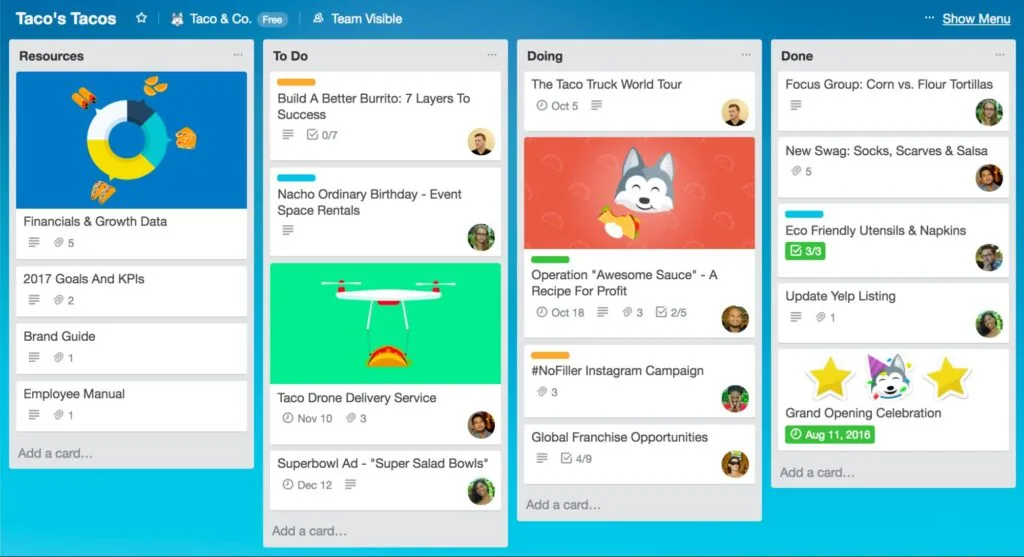
If you’re seeking a project management tool with a simpler board view than Jira, yet still appreciate the card and status update system, Trello might be an excellent choice. Interestingly, Trello is also under the Atlassian umbrella, just like Jira. However, it’s distinct from being just a ‘Jira Lite’.
Trello offers a streamlined approach, ideal for smaller software development teams aiming to manage multiple projects without the complexity of features like story points or issue tracking. It allows the creation of various boards for backlogs, sprints, or upcoming iterations, making it a practical solution at a reasonable price.
A notable aspect of Trello is its power-ups, which allow the addition of functionalities like burndown charts or Gantt charts. These features can be integrated as your team’s needs evolve, without the necessity of an initial commitment to them. All these functionalities are available within an intuitive interface that is user-friendly and engaging.
However, Trello does have its limitations. It confines users to a board view, potentially overlooking the advantages of list or time views for some users. Additionally, cards can become cluttered with comments, which might make alternatives like ClickUp more suitable for certain needs.
Explore top Trello alternatives to understand why options like ClickUp might be a better fit for your project management requirements.
Key Features of Trello:
- Tags, Labels, and Categories – aid in organizing and categorizing tasks.
- Drag and Drop Cards: Simplify task management and prioritization.
- Progress Charts: Offer visual representations of project advancement.
- Set Reminders: Ensure timely task completion.
- Kanban Board View: Enhances task visualization and tracking.
- Task Assignments: Facilitate clear distribution of responsibilities.
- Broad Integration Options: Increase the tool’s versatility and functionality.
Limitations of Trello:
- Restricted Reporting and Analytics: Limits the ability to measure project progress comprehensively.
- No Built-in Time Tracking: This could be a disadvantage for larger teams or more complex projects.
- Limited Free Plan Power-Ups: The free version constrains the use of Trello’s integrations, potentially impacting project management efficiency.
Pricing:
- Trello pricing ranges from free to $17.50/user per month.
16. Clickup

For aficionados of AI-driven content creation, project planning, and email management, ClickUp emerges as a robust alternative to Hive, bolstered by a powerful AI-powered assistant. ClickUp transcends the boundaries of conventional project management tools by integrating AI to enhance content generation within ClickUp documents, streamline project planning, and efficiently summarize email threads. Furthermore, ClickUp’s well-structured task hierarchy, featuring spaces, folders, and lists, adeptly facilitates the organization and segmentation of extensive projects – a domain where Hive sometimes struggles.
Key Features of ClickUp:
- Customizable Task Segmentation: Allows for breaking down projects into manageable tasks, clarifying objectives and facilitating execution.
- Over 15 project views are available, offering varied perspectives to monitor progress effectively.
- Advanced Collaboration Tools: Includes whiteboarding, document management, and proofing for enhanced team interaction.
- Custom Reports and Dashboards: Provide a comprehensive overview of projects and tasks, supporting informed decision-making.
Limitations of ClickUp:
- The extensive array of features can overwhelm and confuse new users.
- Some users report reliability issues with the tool.
- There have been instances of unsatisfactory experiences with customer support as reported by users.
Pricing:
- ClickUp pricing ranges from free to $12/user per month.
Why Look for a Jira Alternative?
- The program is quite sophisticated and full of inefficiencies. Teams responsible for project management have found the customization choices to be a laborious procedure after trying them. The very complicated user experience design of Jira will be a turnoff for anyone trying to increase productivity. Learning how to utilize this interface effectively requires some time and effort.
- Furthermore, Jira’s shortcomings are particularly evident when tasks call for several people to complete. Multiple assignees are not supported by the program. In actuality, participants become observers of the task, offering feedback and addressing problems. But this is disorganized and ineffective since you wind up with two lists: the team really working on the issues and the official Jira assigned person.
- Things might get a little more difficult if you decide to switch from Jira to another free project management tool. Simply attempt to look through their knowledge base sites in search of an exporting option. There won’t be any exporting available—only importing solutions. Alternatively, it might direct you to the Atlassian Jira Marketplace, where you can download apps for various Atlassian products. Moreover, there are plugins that facilitate Jira migration from other programs, not the other way around. Even worse, because they are discontinuing their server solutions, they are now requiring you to relocate to the cloud!
- The price is set in stone. Jira’s cost is a major turnoff. It’s pricey in comparison to a number of simpler, superior project management programs, which suggests that if your team expands, the expense may go even further. Numerous disadvantages of the free plan include lack of capacity planning, automation restricted to a single project, and inadequate dependency management. Furthermore, there isn’t much of a change even if you move from the free plan to the regular plan ($7/user per month). The one site restriction, project-specific automations, and fundamental functionality will all stay the same.

